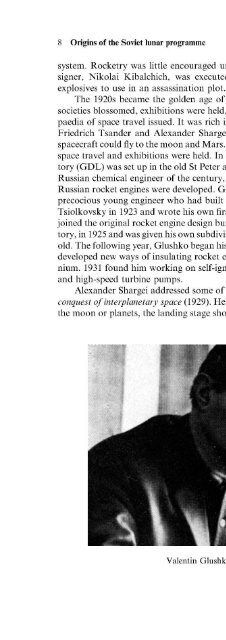- Page 2: Soviet and Russian Lunar Exploratio
- Page 6: Brian Harvey 2 Rathdown Crescent Te
- Page 10: 3 Planning the lunar landing 45 Vos
- Page 14: 8 Return to the moon 287 After N-l:
- Page 18: Prologue Siberia, summer of 1976. N
- Page 22: Although the United States Apollo p
- Page 26: The 8K78 71 The Ye-6 lander 73 Dish
- Page 30: Lunokhod returns to landing stage 2
- Page 34: Abbreviations and acronyms AIS Auto
- Page 38: 1 Origins of the Soviet lunar progr
- Page 42: Sergei Korolev, Mstislav Keldysh Wi
- Page 46: Introducing the father of the Sovie
- Page 50: On rocket research into the upper l
- Page 56: top rocket experts to Germany to pi
- Page 60: end in the Syr Darya river, deep in
- Page 64: 2 The first moon probes Sputnik cha
- Page 68: The first Sputnik made a deep impac
- Page 72: An upper stage: enter Semyon Kosber
- Page 76: Burn times Burn time block A Burn t
- Page 80: Only hours apart: the moon race, au
- Page 84: FIRST COSMIC SHIP Undeterred though
- Page 88: Instruments on the First, Second Co
- Page 92: Following the First Cosmic Ship The
- Page 96: one was not ready until the summer.
- Page 100: Cosmic Ship had been a fraud, or 'a
- Page 104:
The Automatic Interplanetary Statio
- Page 108:
of failure. They had good reason to
- Page 112:
Automatic Interplanetary Station -
- Page 116:
uild crude spacecraft on big dumb b
- Page 120:
This ended the early moon programme
- Page 124:
possibilities explored during this
- Page 128:
Soyuz complex - first block design
- Page 132:
First flights were set for 1964 wit
- Page 136:
Nikolayev, Popovich return in trium
- Page 140:
The Americans want to land a man on
- Page 144:
Vladimir Chelomei Some of the missi
- Page 148:
Whatever the mixed circumstances, t
- Page 152:
Mikhail Tikhonravov at retirement W
- Page 156:
RD-270 engine Length Diameter Press
- Page 160:
N-1, or one that could later be ado
- Page 164:
Vladimir Chelomei and Mstislav Keld
- Page 168:
4 The soft-landers and orbiters Wit
- Page 172:
A The 8K78 block L came in. Block L
- Page 176:
The Ye-6 lander surface. A boom on
- Page 180:
lunar surface, photographs would be
- Page 184:
Luna 4 and the 1963, 1964 rounds of
- Page 188:
ackground was not propitious, for t
- Page 192:
course correction (up to 130m/sec)
- Page 196:
Zond 3
- Page 200:
Lunar map after Zond 3 features of
- Page 204:
KOROLEV DIES: THE MISHIN SUCCESSION
- Page 208:
Arnold Selivanov Luna 9 was down in
- Page 212:
Luna 9 first image was a radiation
- Page 216:
Luna 13 desolation. Luna 9 had done
- Page 220:
Table 4.1. Key events in the progra
- Page 224:
Luna 10 Although the Ye-7 photograp
- Page 228:
Luna 10 enters lunar orbit the Sea
- Page 232:
THE LUNAR PHOTOGRAPHY MISSIONS Now
- Page 236:
Luna 12 images lunar orbiters and d
- Page 240:
Ye-6 series: instruments specified
- Page 244:
Diagram of Luna 14 in a highly irre
- Page 248:
[4] Clark, Phillip S.: Masses of So
- Page 252:
Proton rocket Chelomei's moon rocke
- Page 256:
Russian rockets are limited to a di
- Page 260:
THE ROCKET FOR THE LANDING: THE N-l
- Page 264:
Mstislav Keldysh The N-1 was origin
- Page 268:
of people in Kyubyshev, Moscow, Dne
- Page 272:
The N-1 engine system In an effort
- Page 278:
of being wholly unrealistic. The pl
- Page 282:
them on a visit to Samara and could
- Page 286:
Korolev devoted considerable energi
- Page 290:
As the launch date drew near, there
- Page 294:
Vladimir Komarov and his friend Yur
- Page 298:
Cosmonaut Valeri Kubasov in Zond si
- Page 302:
was difficult to escape in the ocea
- Page 306:
orbital insertion, 188 was only 24
- Page 310:
The spaceship for orbiting the moon
- Page 314:
With the LK down on the surface, th
- Page 318:
The LK of the N-1 rocket would burn
- Page 322:
LK window burn would be done by blo
- Page 326:
the Soviet aviation industry, milit
- Page 330:
Orlan, descendant of the Kretchet
- Page 334:
The operations on the moon would co
- Page 338:
Although no cosmonaut ever did make
- Page 342:
Chief designer Valentin Glushko wit
- Page 346:
This group was selected for the fli
- Page 350:
Sergei Korolev with Konstantin Feok
- Page 354:
Russia's moon team: selection for a
- Page 358:
First group of six: Yuri Gagarin, V
- Page 362:
The moon teams: Moon Team 2: Valeri
- Page 366:
COSMONAUTS SELECTED TO LAND THE LK
- Page 370:
went into the deserts of Somalia so
- Page 374:
Alexei Leonov landed in a forest in
- Page 378:
Oleg Makarov Americans described hi
- Page 382:
Nikolai Rukhavishnikov planned expe
- Page 386:
\ ^ i . Vitally Sevastianov RETURNI
- Page 390:
completely undermined anyway at the
- Page 394:
6 Around the moon The moon race bet
- Page 398:
Zond 5
- Page 402:
Zond 5 in the Indian Ocean Zond 5's
- Page 406:
Zond 6 around the moon Even as the
- Page 410:
Zond over Crater Tsiolkovsky times,
- Page 414:
Remarkably, Zond 6 images survived
- Page 418:
Earthrise for Zond 7 their porthole
- Page 422:
moon programme. Although this was n
- Page 426:
Lunokhod on top of Proton SOYUZ 4-5
- Page 430:
Yevgeni Khrunov, Alexei Yeliseyev d
- Page 434:
Boris Volynov Back in space, Volyno
- Page 438:
N-l ON THE PAD By the time of these
- Page 442:
preparations to send two probes to
- Page 446:
from one brilliant achievement to a
- Page 450:
touchdown, the 90 cm long drill arm
- Page 454:
(the one achieved after major orbit
- Page 458:
Following the first moon landing, t
- Page 462:
of the Earth's full globe over the
- Page 466:
L-1/Zond series: scientific outcome
- Page 470:
initiation down to 1,500 m over the
- Page 474:
match the three days of two Apollo
- Page 478:
Test Peroxide (HTP). Only one other
- Page 482:
21 Feb 1969 3 Jul 1969 27 Jun 1971
- Page 486:
Valentin Glushko, now chief designe
- Page 490:
Salyut - an alternative programme p
- Page 494:
• Successfully tested out its lun
- Page 498:
decided, in 1968, to send an Apollo
- Page 502:
[7] Gracieux, Serge: Le joker Sovie
- Page 506:
KT descent stage Engine One 11D417
- Page 510:
750 kg to 1,920 kg. At highest thru
- Page 514:
Luna 16 stage left on the moon The
- Page 518:
Luna 16 moonrock For NASA and Weste
- Page 522:
Transmash designed tanks for the Re
- Page 526:
To guide the route chosen, Lunokhod
- Page 530:
Lunokhod Weight Diameter Height Whe
- Page 534:
Lunokhod tracks across the moon in
- Page 538:
Lunokhod route-planning conference
- Page 542:
stop to take panoramic pictures. Fo
- Page 546:
End of Lunokhod journey October 197
- Page 550:
ten-hour shifts, 14 lunar days at a
- Page 554:
The drilling operation took 40 min
- Page 558:
Lunokhod 2 Luna 21 entered a near-c
- Page 562:
Lunokhod 2 wheel marks on the moon
- Page 566:
The journey of Lunokhod 2 lunar sur
- Page 570:
that there was a very weak permanen
- Page 574:
It was a full year before the next
- Page 578:
of designers of 1946. He was the co
- Page 582:
Luna 24 returning to the Earth Ye-8
- Page 586:
• Telescopes on the lunar farside
- Page 590:
Valeri Barsukov Despite the heat of
- Page 594:
ACHIEVEMENTS OF THE SOVIET AUTOMATI
- Page 598:
[11] Surkov, Yuri: Exploration of t
- Page 602:
of no fewer than 450 sec. A lunar e
- Page 606:
cosmonaut at a time. As was the cas
- Page 610:
none progressed beyond the aspirati
- Page 614:
engineering and scientific sense, a
- Page 618:
[8] Rebrov, Colonel M.: But this is
- Page 622:
298 List of all Soviet moon probes
- Page 626:
300 List of all Soviet moon probes
- Page 630:
(1988-2003); Gordon Hooper (1990),
- Page 634:
Gorin, Peter A.: Rising from the cr
- Page 638:
Pesavento, Peter: Soviet space prog
- Page 642:
Wright, Pearce: Vasili Mishin - spa
- Page 646:
Bogomolov, Alexei 221 Boguslavsky,
- Page 650:
Kennedy, John F. Moon speech, 52 Pr
- Page 654:
Printing: Mercedes-Druck, Berlin Bi
- Page 658:
Tikhonravov, Mikhail (cont.) Propos







